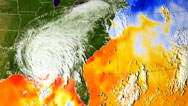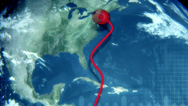Why Did Houston Flood?
- By Ari Daniel
- Posted 09.06.17
- NOVA
Hurricane Harvey's rainfall broke continental U.S. records. Here's how cities like Houston can better prepare.
Transcript
Onscreen: Hurricane Harvey's devastation is without precedent. Trillions of gallons of water drowning the Houston area.
Lisa Gonzalez: We can't really get on the freeways and go anywhere.
Onscreen: Homes and buildings in ruins. Chemical plant explosions. Tens of thousands displaced.
Gavin Dillingham: We have about half a dozen family friends that have had to evacuate. These are two-story houses that they've just kind of walked out of.
Onscreen The death toll is rising. The economic toll is rising. Why did Houston flood so badly?
One reason is the sheer volume of water. Harvey's rainfall broke continental U.S. records. Two opposing high pressure systems stalled the storm for days over Houston. But the rain alone isn't what made the disaster.
This part of the country floods naturally.
Gonzalez: We live on the Gulf coastal plane—the coastal prairies, the wetlands, everything that was here before us, it was built to flood.
Onscreen: The problem: Houston is flat. Mostly marshland barely above sea level. Rapid urban development hasn't helped.
Gonzalez: We've paved over a lot of those habitats that provide a service in terms of soaking up flood waters.
Dillingham: There's nowhere for this water to go other than to flood out into homes and into the community and such.
Onscreen: Major flooding is becoming more frequent in Houston. Climate change isn't helping either. Sea surface temperatures have warmed on average by 1°F in the last few decades.
Dillingham: You have higher evaporation, which means more water in the atmosphere. And it's got to go somewhere, and so you start having torrential rainstorms.
Onscreen: Houston isn't alone. Coastal cities in places already prone to hurricanes are likely to see more intense storms in the future.
So is flooding inevitable? For major storms, yes. But for less intense storms, maybe not.
Houston can usually handle 1-2 inches of rain per hour for a few hours. But it could handle more: by using pavement that allows water to soak into the ground, installing water retention basins, elevating homes and buildings, and using other green infrastructure that captures and slowly releases stormwater. Not to mention conserving and restoring prairies and wetlands since an acre of wetland can hold a lot of water.
Dillingham: The more green space we can get out there, the better it is. The problem is it's very difficult to take these developed properties and turn them back into green fields.
Onscreen:These solutions aren't cheap and restricting development may not be popular.
Gonzalez: As a region, we're going to have to make some tough decisions, I think, about how we decide to develop in the future. Our challenge is how do we deal with those floods and what mechanisms do we put in place to make sure that we keep people out of harm's way.
Onscreen: So when the next big storm comes, will we be ready?
Credits
PRODUCTION CREDITS
- Digital Producer
- Ari Daniel
- Production & Research Assistance
- Elena Renken & Erin Dahlstrom
- Editorial Review
- Julia Cort
Tim De Chant
Caitlin Saks - Special Thanks
- Ellen Douglas
- © WGBH Educational Foundation 2017
MEDIA CREDITS
- Videography & Imagery
- Aerial Cinematography - Aaron Benzel / GO 3D NOW, LLC
Bill Bass/BillBassPhoto.com
Google Maps
Greenpeace / Mannie Garcia
Houston Advanced Research Center
NASA
National Hurricane Center
National Weather Service
NYC Water
REUTERS / Johanna Strickland
ezview.wa.gov
flickr.com / Coast Guard News & Dan Baxter
pexels.com
pixabay.com
shutterstock.com / soraphotography
wikimedia.org - Music
- APM
POSTER IMAGE
- (main image: aerial flooding)
- Aaron Benzel
Related Links
-

Killer Hurricanes
Experts reconstruct the Great Hurricane of 1780 to help predict the risk of future storms.
-

Stronger Hurricanes
Is global warming making hurricanes more intense?
-

When Hurricane Sandy Went Rogue
What started out as a tropical storm evolved into one of New York City's worst nightmares.
-

Sea Level Rise: When 1 in = 2 ft
Sea levels will rise by the same amount all over the world, right? Wrong. Here’s why.

